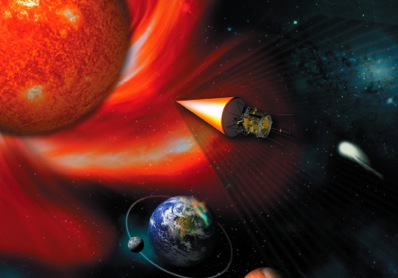|

Journey to the centre of the Sun
BY DR EMILY BALDWIN
ASTRONOMY NOW
Posted: June 10 2008
NASA is planning a mission to the Sun that will go closer to our life-giving star than any spacecraft has ever gone before to solve two of the greatest mysteries of solar physics.
"We are going to visit a living, breathing star for the first time," says program scientist Lika Guhathakurta of NASA Headquarters. "This is an unexplored region of the Solar System and the possibilities for discovery are off the charts."
Solar Probe+ (Solar Probe Plus) is still in its early design phase, but launch could happen as early as 2015. The spacecraft will spend most of its lifetime plunging deep into the Sun’s atmosphere where it will taste the solar wind and magnetism first hand. These plunges will be accomplished by means of Venus flybys to bend the probe’s trajectory deeper and deeper into the solar corona.

Artist concept of the Solar Probe with the glowing cone of the Thermal Protection System (heat shield) pointed toward the Sun. The mission will teach us about the interaction of the solar wind with planets, asteroids and comets. Image: http://solarprobe.gsfc.nasa.gov/.
At closest approach the heat-resistant spacecraft will be just 9 solar radii (7 million kilometres) from the Sun, where temperatures exceed 1400 degrees Celsius and radiation doses are unimaginable. From this close-up view the Sun will appear 23 times wider than it does from the Earth. At least there will be no shortage of solar power, which will provide the spacecraft’s energy, although it will also require liquid-cooled solar panels that can retract behind heat shielding when the sunlight becomes too intense.
Solar Probe+’s planners believe that the mission could solve two of the greatest mysteries of solar physics: why is the solar corona hundreds of times hotter than the star below? – the surface of the Sun is 6000 degrees Celsius but the corona is over one million degrees – and, what gives the solar wind its huge velocity? Planets, comets and asteroids all feel the force of the solar wind, but curiously there is no organised wind near the Sun’s surface. Somewhere in between an unknown factor gives the solar wind a veritable boost.
"To solve these mysteries, Solar Probe+ will actually enter the corona," says Guhathakurta. "That's where the action is. In-situ measurements will tell us what we need to know to unravel the physics of coronal heating and solar wind acceleration.”
The probe will also make 3D images of the Sun’s corona similar to way medical CAT scans are produced.
It is hoped that the probe will begin its solar survey towards the end of Solar Cycle 24 in 2015 and finish near the predicted maximum of Solar Cycle 25 in 2022, enabling the probe to sample the corona and solar wind at many different points of the solar cycle. It will also have a front row seat for viewing solar storms, and as many researchers suspect that the most dangerous particles produced by solar storms are energised in the corona, where Solar Probe+ will be, the data collected could show researchers how to forecast Solar Energetic Particle events that threaten the health and safety of astronauts.
For more information about the mission see the Solar Probe website at: http://solarprobe.gsfc.nasa.gov/
|



